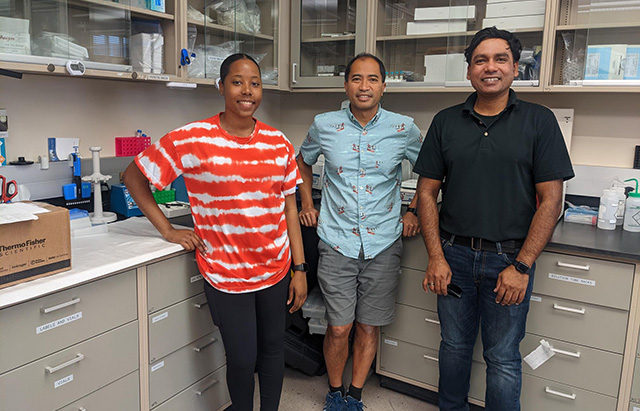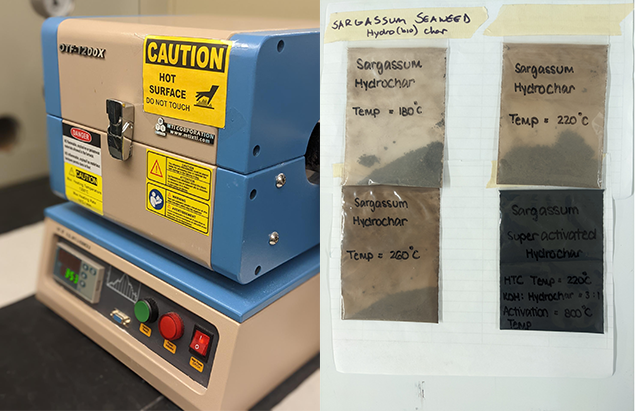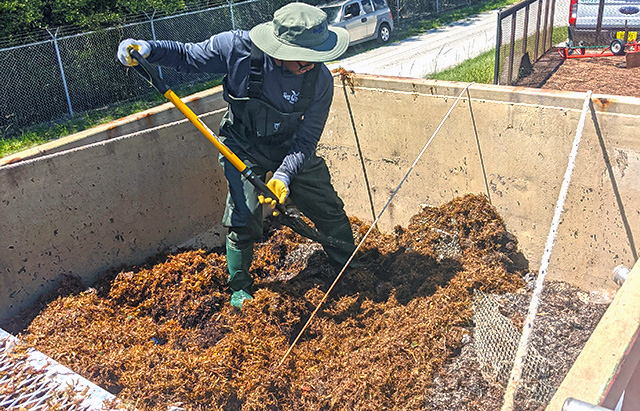
Ph.D. student Cadianne Chambers (left), Dr. Vincent Encomio (center), and project PI Dr. Toufiq Reza of FIT (right) within the lab
Notorious for crowding sandy shores in the summer and leaving a distinguished odor, Sargassum may have an unexpected purpose in saving Florida’s estuaries from harmful algal blooms (HABs). Florida Sea Grant’s multi-county extension agent Dr. Vincent Encomio is working with Florida Institute of Technology (FIT) researchers to reduce the impacts of HABs in the St. Lucie River and Estuary using Sargassum-derived biochar, an organic material rich in carbon with sponge-like properties.
Why Sargassum?
The proposal to use Sargassum as a source of biochar originated from the necessity to repurpose excess seaweed. Sargassum is essential for marine life, serving as a primary nursery area for fish, sea turtles, birds, crabs, shrimp, and more. However, thick accumulations can block sunlight, deplete oxygen from water as it decomposes, clog boat engines, cause a massive fish kill, and affect human health.
“The intriguing thing about this work is using a harmful algal bloom to treat other blooms,” says Dr. Encomio. “Sargassum is an established problem in the Caribbean and south Florida as it is piling up on beaches, so there has been a growing industry of finding ways to use excess Sargassum in new, beneficial ways.”
The intriguing thing about this work is using a harmful algal bloom to treat other blooms.
Dr. Vincent Encomio
How does biochar mitigate HABs?
Estuarine habitats and species typically thrive off nutrient-rich ecosystems from fresh and saltwater. However, nutrients from Lake Okeechobee and the watershed around St. Lucie has caused an increase in cyanobacteria and visible blue-green algae.
In the summer of 2016, blue-green algae covered 60% of Lake Okeechobee and 90% percent in 2018, resulting in several state emergency orders around the lake. Following these events, the St. Lucie River, which connects to Lake Okeechobee via canal C-44, experiences frequent algal blooms.

A tube furnace (pictured left) is used to synthesize biochar in the laboratory.
Biochar is a charcoal-like substance, with lightweight and porous properties which allows for the absorption of nutrients and pollutants. It is typically derived from grass, plant trimmings, forest cuttings, and other organic material that undergoes decomposition using high temperatures and minimal oxygen in a process known as pyrolysis.
With support from Florida Sea Grant and the Environmental Protection Agency, Dr. Encomio, and his colleagues focus on producing the desired quality and quantity of biochar under several pyrolysis treatments. So far, the researchers have experimented with temperatures ranging from 180 degrees Celsius to 800 degrees Celsius.
Once biochar samples are produced, researchers will observe the biochar adsorption of cyanobacterial toxins such as microcystin. In a laboratory, the research team will treat liquid samples containing microcystin using biochar, and then filter, extract, and analyze the samples for traces of microcystin.
Future prospects
Compared to other harmful algal bloom mitigation strategies, biochar is the least harmful and most cost-effective solution. Other control methods like algaecides and peroxide pose toxic threats to non-targeted species. Since biochar is produced locally, it is also relatively inexpensive.

Encomio collecting Sargassum from the FPL power plant in St. Lucie County for a composting pilot project
According to Dr. Encomio, there are still big questions on Sargassum-derived biochar that need answers. Dr. Encomio was part of a larger Florida Sea Grant and UF/IFAS team that collaborated on investigating composting Sargassum.
“Sargassum species accumulate arsenic, which was a primary concern when investigating whether it can be composted,” says Dr. Encomio.
The current biochar project will provide new and additional opportunities for Sargassum usage while studying the chemical and physical properties to see how effective and safe Sargassum-based biochar is.
While the research is currently undergoing the stages of producing the desired biochar product, Dr. Encomio looks forward to the research’s prospect of restoring the health of the St. Lucie River and the Indian River Lagoon. With his collaborators at FIT, Dr. Encomio is also eager to examine other applications of biochar that may enhance coastal health and aquaculture production.